О компании Центр Инновационных Технологий
ИСТОРИЯ
«Центр Инновационных Технологий» входит в состав группы компаний «ТЕНТО Инжиниринг» – одного из крупнейших игроков рынка системной интеграции Пермского края, начавших свой путь в 1992г. с реализации комплексных проектов в сегменте Hi-Tech: телекоммуникации, промышленная автоматизация, информационные технологии, системы безопасности и пр.
В 2008 году в составе группы создано бизнес-направление – инжиниринговая компания «Центр Инновационных Технологий», которая специализируется на комплексной поставке и инжиниринге технологий для решения современных научно-исследовательских задач.
С 2012 года ЦИТ является самостоятельной независимой компанией, реализующей проекты по внедрению высокотехнологичного оборудования и созданию научно-исследовательских лабораторий.
КОМПЛЕКСНЫЙ ПОДХОД
В своей работе мы системно и комплексно подходим к решению поставленных задач с привлечением лучших зарубежных и российских ученых и инженеров.
ИННОВАЦИИ В ФОКУСЕ
Сегодня, в эпоху бурного роста научных знаний и революционных открытий важно шагать в ногу со временем, фокусируясь на современных прикладных технологиях, способных соответствовать вызовам развивающегося рынка.
«Центр Инновационных Технологий» – это команда профессионалов, способная предложить свои знания и опыт для решения задач самого высокого уровня сложности.
ГЕОГРАФИЯ И КЛИЕНТЫ
Наши клиенты:
- высшие учебные заведения
- исследовательские институты
- институты Российской академии наук
- инновационные производственные предприятия
Перми, Челябинска, Екатеринбурга, Казани, Санкт-Петербурга. Мы последовательно наращиваем наши деловые связи по всей России.
Наши партнеры:
- зарубежные образовательные и исследовательские институты
- инжиниринговые компании
- производители и поставщики высокотехнологичного оборудования
- инновационные компании
расположены по всему миру: в России, Германии, Италии, Франции, Южной Корее, Китае, США, Канаде, Великобритании, Японии, Индии и др.
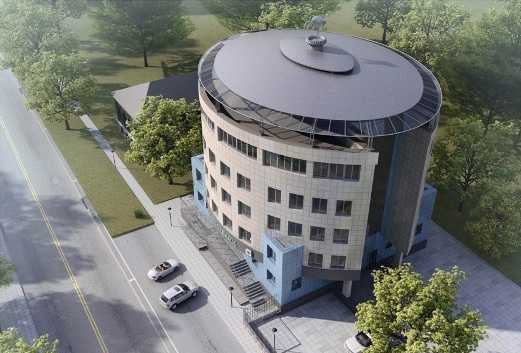
www.innfocus.ru
Центр инновационных технологий – Register IMC
During the first launch of the program the “Registration” window which contains Identification number
and Setup key will be opened.
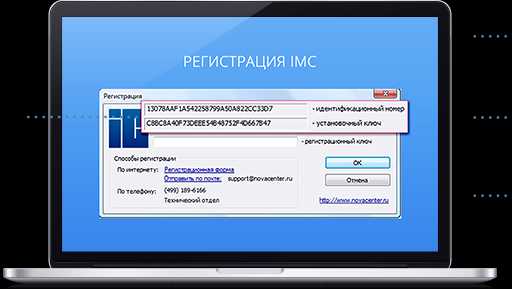
During the first launch of the program the “Registration” window which contains Identification number and Setup key will be opened.
To register software via website, follow “Registration form” link. On the opened page enter Identification number to the first text-box, and enter the Setup key to the second text-box. Fill the text-boxes with your personal details (Surname, Name, Organization, E-mail, Country), then press “Register” button. You will be provided with the registration key, which should be copied to the “registration” window of IMC software. Then press “OK” button to finish the registration process and launch the program.
Another way of receiving the registration key is to send Identification number and Setup key to [email protected] e-mail. You will be sent the e-mail reply with the registration key, which should be copied to the “registration” window of IMC software. Then press “OK” button to finish the registration process and launch the program.
To register IMC software via phone call, please contact technical support department by the following phone number: +7 (499) 189-61-66.
For questions about software please contact technical support by [email protected] e-mail or make a phone call +7 (499) 189-61-66:
+7 (499) 189-61-66.
www.novacenter.ru
Центр инновационных технологий – Features
Primary processing of Resurs-P1, 2, 3, Kanopus-V and BKA satellite data
560thousands of km2coverage
Technology of remote sensing data primary processing within IMC software is fully automated and allows user to perform the formation of the scenes for Resurs-DK, Resurs-P1, 2, 3, Kanopus-V1, BKA imagery. Primary processing contains following steps: geometrical correction of the scene using digital elevation model and RPC coefficients, radiometric correction, eliminating offset between spectral bands, formation of synthesized color image, and formation of fused image in natural colors with resolution of panchromatic image. Further processing such as spatial resolution improvement, color correction, georeferencing improvement, etc provides a possibility to significantly increase the quality of the output data
Resurs-P
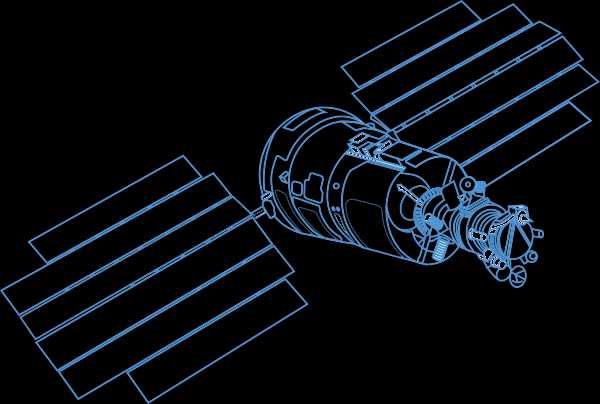
Resurs-P1 was launched on the 25th of June 2013 from Baikonur Cosmodrome and accepted into regular operation on the 30th of September 2013.
Resurs-P2 was launched on the 26th of December 2014 from Baikonur Cosmodrome.
Resource-P3 was launched on the 13th of May 2016 from Baikonur Cosmodrome.
Developer: TsSKB Progress
Operator: NTs OMZ RSS.
The spacecraft is capable of photographing individual targets on the Earth surface, as well as long stretches of Earth surface extending as far as 2,000 kilometers. Resurs-P could also image areas 100 by 300 kilometers during a single pass and conduct stereo-imaging.
Resurs-P is designed for maps update, environmental control and protection; among the users of the satellite data there are following institutions: Ministry of Natural Resources, Ministry of Emergency Situations, Ministry of Transportation, Ministry of Agriculture, Ministry of Fishing, Ministry of Meteorology and other domestic and foreign customers.
More
Optical-electronic high resolution equipment
| Characteristics | Panchromatic band | Multispectral band |
| Swath width image, Km | 38 | |
| Spatial resolution (at nadir), m | 0,9 | 3-4 |
| Spectral range, µm | 0,58÷0,80 | blue (0,45÷0,52) green (0,52÷0,60) красный (0,61÷0,68) red 1 (0,67÷0,70) red 2 (0,70÷0,73) red + near IR (0,70÷0,80) |
Wide-multispectral equipment of high and medium resolution
| Characteristics | ShMSA-VR | ShMSA-SR | ||
| Panchromatic band | Multispectral band | Panchromatic band | Multispectral band | |
| Swath width image, km | 97 | 441 | ||
| Spatial resolution (at nadir), m | 12 | 23 | 60 | 120 |
| Spectral range, µm | 0,43÷0,70 | blue (0,43÷0,51) green (0,51÷0,58) red (0,60÷0,70) near IR 1 (0,70÷0,80) near IR 2 (0,80÷0,90) | 0,43÷0,70 | blue (0,43÷0,51) green (0,51÷0,58) red (0,60÷0,70) near IR 1 (0,70÷0,80) near IR 2 (0,80÷0,90) |
Hyperspectral equipment
| Characteristics | GSA |
| Swath width image, km | 22 |
| Spatial resolution (at nadir), m | 30 |
| Spectral range, µm | 0,4÷1,1 (up to 256 spectral bands) |
Kanopus-V1, BKA
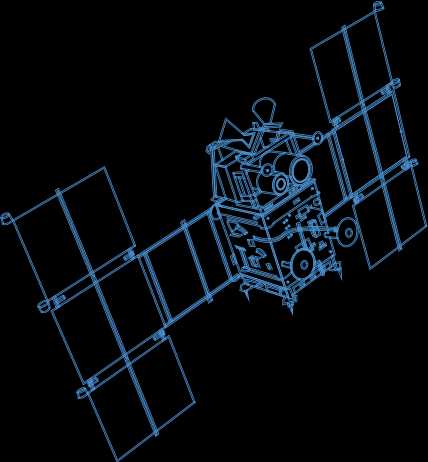
Kanopus-V1 is a Russian spacecraft designed for real-time technogenic and natural disasters monitoring. It was launched on the 22th of July 2012 from Baikonur Cosmodrome. Data acquired from Kanopus-V1 spacecraft contain RPC-for faster image processing and image accuracy improvement.
BKA (Belorussian spacecraft) was launched together with Russian Kanopus-V1 and has identical characteristics.
More
| Characteristics | Panchromatic band | Multispectral band |
| Swath width image, km | 23 | 20 |
| Spatial resolution (at nadir), m | 2,5 | 12 |
| Spectral range, µm | 0,58÷0,86 | blue (0,45÷0,52) green (0,51÷0,6) red (0,61÷0,69) near IR (0,75÷0,84) |
Data processing sequence in IMC software
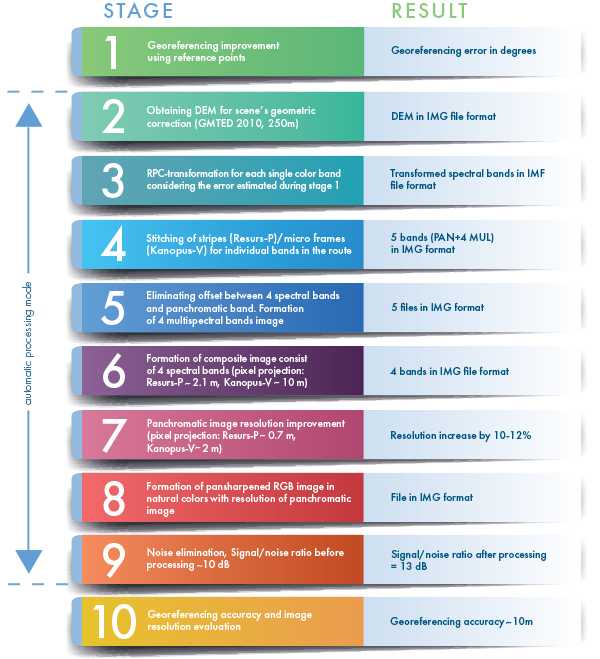
Preliminary processing
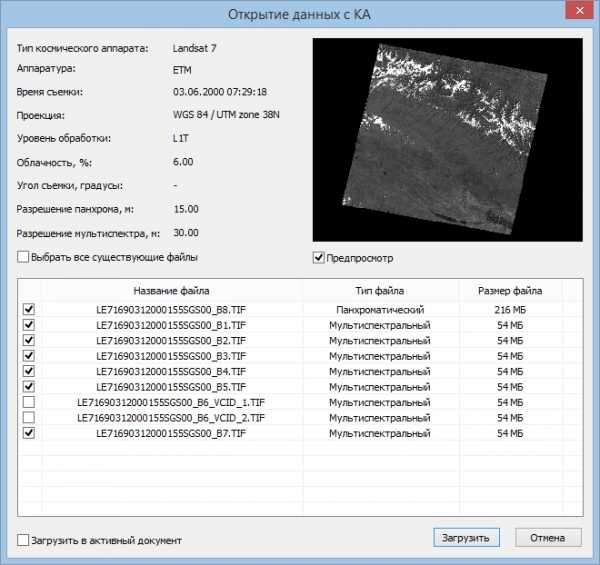
Preliminary processing contains following steps:
- reading image’s metadata file;
- formation of multispectral image;
- assigning color components;
- image atmospheric correction;
- removing uninformative areas;
Scene’s metadata file is stored in the data package along with the image in XML or TXT file formats. IMC provides a possibility to read metadata files and open related scenes automatically.
Characteristics of color bands such as range, width, gain, offset, along with the satellite and sensor type, surveying date and time, resolution, and information about cloud coverage will be read and filled automatically.
All of the information read from the metadata file is useful for further image processing.
Atmospheric correction is required for further thematic processing of the image. User can select one of listed atmosphere transmission plots or upload a new one.
Here you can see Landsat-8 image and averaged atmosphere transmission plot. On the left there is an original image, on the right – image after atmospheric correction was performed.
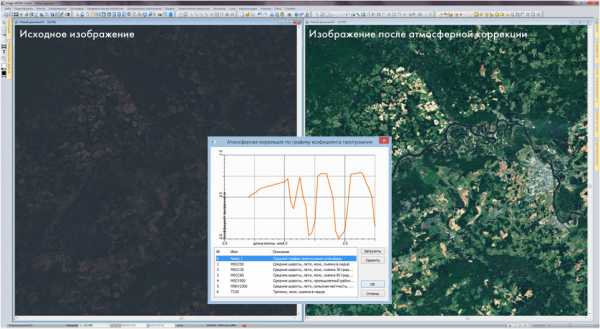
Pansharpening
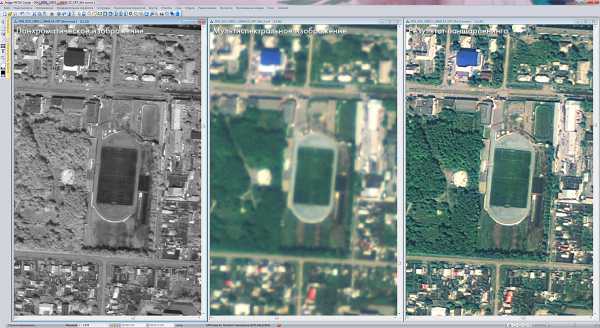
Image: Russian Federation, Chelyabinsk Oblast, Resurs-P1 (Geoton-L1)
Pansharpening is a process of merging high-resolution panchromatic and lower resolution multispectral imagery to create a single high-resolution RGB image.
You can see images obtained from Resurs-P1 spacecraft:
- panchromatic image;
- multispectral image;
- pansharpened image.
You can see images obtained from WorldView-3 spacecraft:
- panchromatic image;
- multispectral image;
- pansharpened image.

Image: Australia, Sydney, WorldView-3
Thematic processing
Thematic processing methods provide a possibility to perform a detailed analysis of the satellite imagery and create vector maps filled with attributive information as the result of the processing both manually and automatically. There are various algorithms for remote sensing data thematic processing implemented within Image Media Center software.
1. False color image analysis

Image: Russian Federation, Sakha Republic, Landsat-8
False color image analysis includes following actions:
- selecting different combinations of color components;
- maximum likehood method;
- using various color spaces (RGB, CMYK, Lab, HLS, HSB).
On the left image you can see the original image obtained from Landsat-8 satellite; on the right – false color image (bands 7-6-4).
2. Indices calculation and analysis
Pixel brightness values of index image are the result of mathematical operations on brightness values of each pixel for different color bands.
Various indices are used for different research purposes:
- vegetation indices;
- soil indices;
- water indices;
- snow and ice indices;
- custom indices.
“Band calculator” tool is designed to create index images; it allows user to perform various mathematical operations on spectral bands.
To create a land surface temperature map a sequence of auxiliary calculations should be performed (such as spectral emissivity, surface brightness temperature, etc.), obtained values can be converted into various units of temperature; a universal color range is used to create a colorful land surface temperature map. Temperature maps allow user to detect areas of abnormal temperatures and discover wildfires and burned areas.

Image: Russia, Kamchatka Krai, Landsat-8
3. Clustering (unsupervised k-means classification)
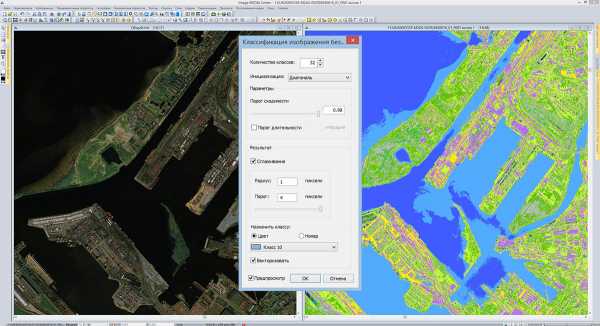
Image: Russian Federation, St. Petersburg, WorldView-2
It is unknown in advance before the clustering which and how many types of objects are present on the image, thus after the image clustering it is necessary to identify the classes recognized by unsupervised classification. Unsupervised classification is usually applied in the cases, such as:
- when it is unknown in advance which types of objects are present on the image;
- when there is a large amount of objects (30<) with complex borders on the image;
- auxiliary step before supervised classification.
4. Supervised classification
Supervised classification requires manual preparation where operator determines reference areas on the image for each class of objects. For classes recognition pixel brightness values of reference areas are used for each spectral band. Thus each pixel of the image will be assigned to a certain class as a result of consequential comparison with all selected references.
On the image you can see the result of the supervised classification based on Resurs-P ShMSA-SR data.

Image: India, Resurs-P, ShMSA-SR
5. Spectral analysis
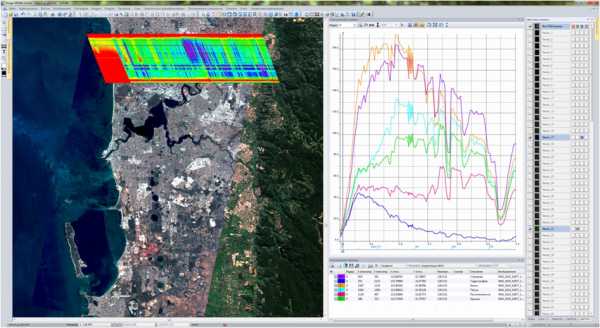
Image: Australia, Pert, Resurs-P (GSA)
The main values to be changed in the spectral analysis, is the wavelength, the intensity of the reflected signal and the spatial coordinates of investigated surface. IMC software provides the following methods of spectral analysis:
- correlation with/without considering amplitude;
- binary encoding;
- spectral angle mapper;
- orthogonal subspace projection.
On the image you can see hyperspectral image by Resurs-P satellite, spectrogram for the row of pixels, and spectral plots for different types of objects.
Working with vector data
IMC software allows user to create vector objects of any complexity (markers, lines, polygons, complex objects), create and assign custom display styles for vector objects, create vector classifiers for different types of objects, scale factor, and attribute data.
Vector layers can be saved in popular file formats SHP and the TAB, as well as in the IMF file format which allows user to store raster and vector layers with attribute information in a single file.
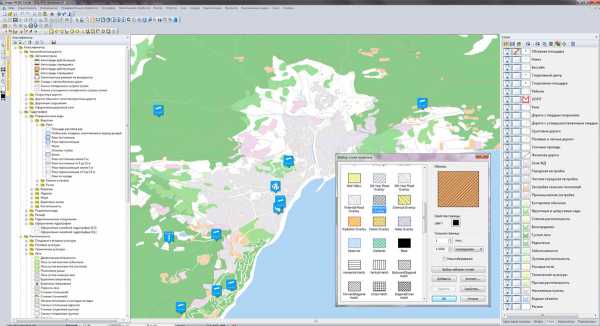
Reports
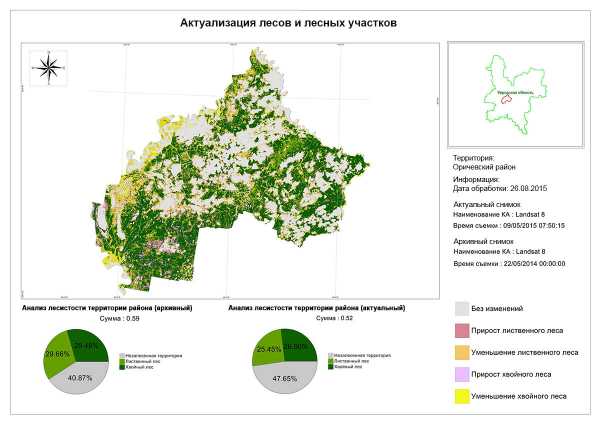
For comprehensive analysis of the results of the processing, statistical reports can be generated automatically. Reports can contain all types of visual representation of statistical data such as graphs, legends, information about the scene etc., as well as satellite images and thematic maps. User can create custom report drafts for convenient demonstration of the results of various thematic processing.
On the image you can see the report that demonstrates the forest cover change over the period of monitoring based on multi-temporal analysis of Landsat-8 images.
www.novacenter.ru
Теплицы из поликарбоната в
Предлагаем более сотни товарных позиций в одном каталоге – все, что нужно для благоустройства вашего участка:
Теплицы из поликарбоната любого типа и размера. Подберем теплицу, учитывая площадь участка и климатические условия вашего региона. Предложим модели собственного изготовления или порекомендуем проверенного производителя без переплат. Минимальная гарантия – от 12 месяцев. Научим, как использовать теплицы из поликарбоната правильно, чтобы продлить срок службы.
Парники и комплектующие для теплиц. Поможем укомплектовать теплицы для любых целей и условий эксплуатации. Готовы выполнить индивидуальные требования, воплотить идеи заказчиков.
Профили и поликарбонат для самостоятельной сборки. Недорогие листы сотового, профилированного и монолитного поликарбоната в розницу и оптом. Продаем поликарбонат от проверенных производителей – Саннекс, Сотолайт, Беролюкс и другие марки. Прозрачный и цветной поликарбонат толщиной от 4 до 16 мм. Подскажем, как сэкономить на строительстве теплицы из поликарбоната без ущерба для качества.
Любые товары для отдыха – от садовой мебели до детских комплексов. Закупаем напрямую от производителя и предлагаем честную стоимость с официальной гарантией. Не боятся морозов и влаги, не выцветают на солнце. Только безопасные краски без красителей, защита острых углов и антикоррозийная обработка.
Предлагаем заводские теплицы из поликарбоната для самого большого урожая:
- Жесткий каркас для высоких нагрузок. Теплицы из поликарбоната не боятся механических повреждений и выдерживают воздействие негативных погодных факторов. Снеговая нагрузка до 180 кг/м2 для регионов с суровым климатом.
- Качественный парниковый эффект за счет герметичного исполнения. В теплицах из поликарбоната сохраняется стабильный микроклимат. Рассада защищена от ранних весенних заморозков. Можно собирать урожай даже после завершения сезона.
- Простая модульная конструкция. Легко собрать и также легко разобрать. Устанавливайте теплицы своими руками, или мы выполним монтаж сами.
- Гарантия от производителя на теплицы 12 месяцев. Срок эксплуатации теплицы более 20 лет.
- Устанавливаем теплицы от производителя в Краснодаре на фундамент, брус или в открытый грунт с помощью «Т» образных ножек.
Доставляем теплицы из поликарбоната по территориям: Краснодар и Краснодарский край, Ростов-на-Дону и Ростовская область , Волгоград и Волгоградская область. Собираем теплицы в Краснодарском крае в кратчайшие сроки. Быстрее чем вы ожидали!
www.cit-donsk.ru
Национальный центр развития инновационных технологий
Цели
Научное обеспечение эффективного использования природных ресурсов и развития топливно-энергетического комплекса России на основе новейших достижений наук о Земле, информатики, физики, прикладной математики, компьютерной техники.
Задачи
- Научное обеспечение нормативно-правовых и экономических механизмов управления в использовании природных ресурсов и энергетике.
- Создание и применение инновационных технологий поиска и разведки месторождений в сложных условиях, в том числе на континентальном шельфе; оптимальное управление разработкой месторождений на основе геолого-гидродинамического моделирования с помощью суперкомпьютерных систем; выявление невыработанных запасов сырья на действующих месторождениях, сокращение потерь и выбросов сырья.
- Создание интегрированных систем экологического и технологического мониторинга природных ресурсов и топливно-энергетического комплекса на базе IT-технологий, современных систем сбора и обработки данных с использованием сети суперкомпьютерных Дата-центров.
- Развитие системы подготовки отечественных специалистов с высшим образованием и высшей квалификацией на базе новейших достижений теоретической и прикладной науки в сфере экологии, природопользования, охраны и эффективного использования недр и окружающей среды.
- Обеспечение информационной и инновационной деятельности в нефтяной и газовой промышленности
- Приоритетные направления деятельности
- Научно-техническое сопровождение реализации новых технологических решений
- Научное обеспечение экономического и нормативно-правового механизмов управления недропользованием
- Научно-технологическое обеспечение развития и повышения эффективности использования минерально-сырьевой базы
- Создание информационных технологий изучения, мониторинга и управления разработкой углеводородного сырья
- Формирование национальной инновационной деятельности по всем звеньям технологической цепочки нефтегазового комплекса – геологоразведочные работы, подсчет запасов и проектирование, добыча, переработка, охрана окружающей среды
- Развитие международного научно-технического сотрудничества.
Руководство
Президент Н. П. Лаверов — вице-президент РАН, председатель Национального комитета геологов РФ, академик РАН
Первый Вице-президент — исполнительный директор В. Е. Цой — президент ГК «ТАЙМЗИКС», д.э.н.
Вице-президент А. Н. Дмитриевский — директор Института проблем нефти и газа РАН, академик РАН
Вице-президент Р. И. Нигматуллин — член Президиума РАН, директор Института океанологии им. П. П. Ширшова РАН, академик РАН
Вице-президент А. Д. Балашов — исполнительный директор ГК «ТАЙМЗИКС», к.ф.-м.н.
Участники
dic.academic.ru